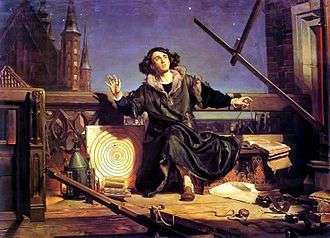Astronomer Copernicus, or Conversations with God
| Polish: Astronom Kopernik, czyli rozmowa z Bogiem | |
 | |
| Artist | Jan Matejko |
|---|---|
| Year | 1873 |
| Medium | oil on canvas |
| Dimensions | 225 cm × 315 cm (89 in × 124 in) |
| Location | Collegium Novum, Jagiellonian University |
Astronomer Copernicus, or Conversations with God (Polish: Astronom Kopernik, czyli rozmowa z Bogiem) is an oil painting by the Polish artist Jan Matejko, finished in 1873, depicting Nicolaus Copernicus observing the heavens from a balcony by a tower near the cathedral in Frombork (seen in the back). Currently the painting is in the collection of the Jagiellonian University of Kraków, which purchased it from a private owner with money donated by the Polish public.
The painting presently adorns the Aula of the Collegium Novum of the University. As with many other works, Matejko painted his artwork in 1872 as part of a series of paintings intended to represent profound moments in the history of Poland.
History

Matejko began his work on this painting in 1871, in preparation for the celebrations of the anniversary of Copernicus's 400th birthday. As with most of his works, it was part of his efforts to represent profound moments in the history of Poland. He studied materials available in the Jagiellonian University, and prepared several pencil and two oil sketches before finishing the final painting. He began work on the final painting in the summer of 1872 in the cramped conditions of his old apartment in Kraków, which he portrayed in the ironic self-Portrait (he would finish Astronomer Copernicus... in a new studio in early 1873).[1]
The organizers of the festivities in Kraków were not supportive of Matejko's endeavour, and did not plan to display his painting during the official festivities. The German council of Toruń approached Matejko with an offer to buy it, but he refused, probably motivated by Polish patriotism, preferring instead to organize his own exhibition in Kraków. He was able to organize a display in February, in Kraków's City Council building, the Wielopolski Palace; profits from the display were donated to charity. The reception of the painting was mixed; later that year it was displayed in Vienna. In March the community of Kraków decided to buy the painting for 12,000 Polish zloty, and it was donated to the Jagiellonian University, where it has been on public display in the Collegium Novum building ever since.[1]
Analysis
The painting depicts a kneeling, inspired Nicolaus Copernicus observing the heavens transitioning from night to dawn. He is on a balcony, near or at the cathedral in Frombork, surrounded by various astronomical tools and aids. The scene likely portrays the epiphany moment of Copernicus profound discovery, with his own Heliocentric model drawn on a large flat board (based on an illustration from De revolutionibus) standing next to him.[1]
The exact location depicted by Matejko is fictional; modern scholars are still looking for the exact location of the Copernicus observatory, and agree that Matejko's portrayal was more of a "romantic vision". Whereas Matejko shows Copernicus on a tower, in reality his small observatory was probably set up at ground level, possibly in the gardens near his house.[2]
The main features of the composition include a symmetrical focal point with atmospheric perspective around the subject, a radial balance of light arranged around a central element, and dramatic contrasts with dark colours in the periphery. Copernicus's epiphany or ecstasy is captured through the skillful use of lighting. The models for Copernicus are known to have been Doctor Henryk Levittoux and Matejko's nephew, Antoni Serafiński.[1]
Matejko's most famous paintings are usually large group scenes; individual scenes like this are more of an exception for him.[1]
References
| Wikimedia Commons has media related to Paintings by Jan Matejko. |
- 1 2 3 4 5 Janina Mazurkiewicz (2010-05-27). "Astronom Kopernik czyli Rozmowa z Bogiem". Muzeum Okręgowe. p. 3. Retrieved 2012-05-26.
- ↑ Natasza Jatczyńska. "Skąd Kopernik patrzył w niebo?". DziennikBaltycki.pl. Retrieved 2012-05-25.